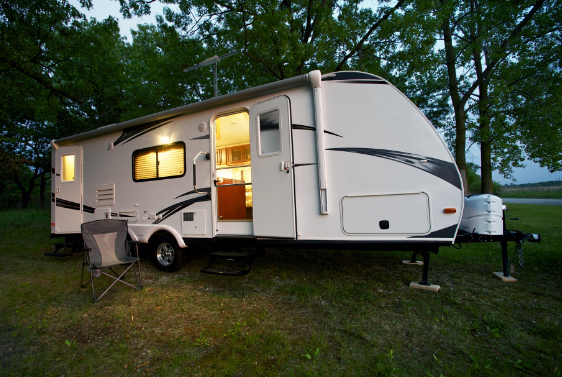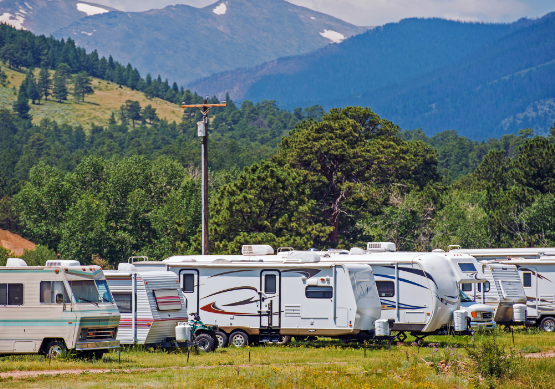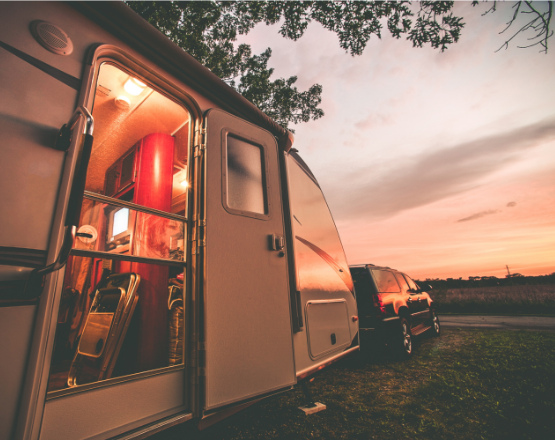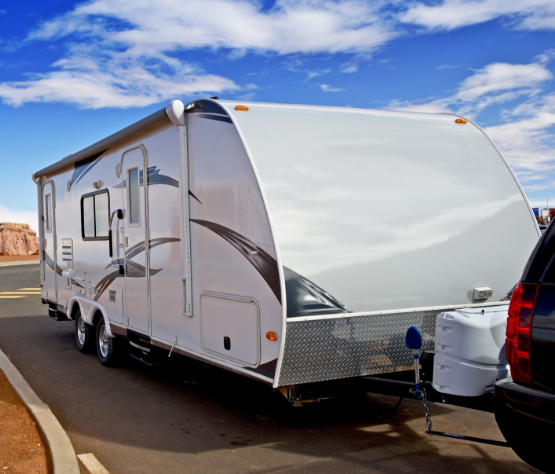Pull Behind Campers and Travel Trailers
Approximately 11 million Americans possess some sort of recreational vehicle. Some people travel in RVs, while others like 5th Wheels, and yet others just hit the road with campers strapped to their trucks. The pull behind camper, or travel trailer, is one type of RV that is becoming increasingly popular.
While some like to live permanently in a travel trailer, others just use them while camping. It’s time to examine the advantages and information regarding travel trailers to find out what the fun and fuss are about. Here is a simple guide to pull behind campers and travel trailers!
What Are Pull Behind Campers and Travel Trailers?
Do pull behind campers and travel trailers represent yet another RV model? They are, in a way, a “recreational vehicle.” It can be connected to the electrical breaker of a campsite and has a sleeping area and a recreation area. It is also “mobile.” Travel trailers, RVs, 5th wheels, and pull behind campers, however, differ significantly from one another in several important ways.
In addition to its many other titles that reflect how they move along the road, travel trailers are sometimes referred to as pull-behind campers, camper trailers, bumper pull campers, towable campers, and many other terms. These pull trailers must be towed by a different vehicle, as their name suggests. The comparison between travel trailers and fifth wheels is frequently closer. While all 5th wheels and travel trailers require towing, 5th wheels provide a little bit more stability. This is due to the fact that 5th wheels are often significantly larger and heavier than travel trailers.
Types of Travel Trailers and Pull Behind Campers
The following are the different types of travel trailers and pull behind campers, so if you want to get one, consider all these options:

Pop-Up and Folding RV Trailers
Consumers on a tight budget who desire a lighter RV that can be pulled behind many ordinary family vehicles, including some small automobiles, are fond of pop-up campers, also known as folding camping trailers. Pop-ups fold down to a smaller size, making it simple to store and carry them. This kind of RV also enables the user to feel more in tune with the environment and connected to the outdoors by imitating the sensation of sleeping outside.
Traditional Travel Trailers
Towable recreational vehicles that are classified as travel trailers are the most common form of RV on the market. They have solid walls and frequently have a slide, which is a part of the inside wall that either pulls out or motors out to provide additional space when camping. Travel trailers are available in a dizzying array of dimensions and layouts; here’s how you choose one.
Fifth-Wheel RV Trailers
Fifth-wheel trailers are meant to be placed on the beds of pickup trucks and pulled by them. You’ve likely seen this type of trailer as its front extends over the bed of the truck, and it is equipped with a hitch that is positioned directly beneath the forward quarters. The trailer is secured in position in the bed of the pickup truck.
Fifth-wheel trailers are often rather large and weighty, necessitating the use of at least a half-ton vehicle that has been specifically designed by the manufacturer to be able to haul huge loads.
Toy Haulers
Toy haulers, sometimes known as “sport-utility trailers,” are available in every single type of travel trailer. They are used to house things like motorcycles, ATVs, and other outdoor playthings. You can drive these toys off the trailer thanks to the ramp that is built into the back of the trailer. After the toy has been unloaded, the ramp itself is frequently suitable for use as a porch.

Truck Campers
No additional hauling is required because truck campers are designed to fit inside the bed of a pickup truck. In order to provide additional room for living, they frequently extend over the roof of the cab of the truck. The sides of lightweight “expedition type” models typically have cloth sides that pop up in the shape of a net to add additional headroom.
What Makes Pull Behind Campers Different?
There is one key distinction between travel trailers and 5th wheels, despite all of these similarities: in many jurisdictions, it is permissible for people to ride in a 5th wheel. Travel trailers do not allow passengers. It is always against the law, regardless of where you are, to travel in a travel trailer.
Campers serve primarily one function, which is to provide cheap shelter and sleeping accommodations for travelers. They are significantly more compact and may be mounted directly on your vehicle, but they do not provide ample storage space. If your traveling party will consist of more than two persons, you should look into larger accommodations.
How Much Can a Pull Behind Camper or Travel Trailer Cost?
The price of a camper trailer can range anywhere from $10,000 to $200,000, depending on the make, model, size, and additional features and luxuries that the buyer desires. If you are searching for a general price range, though, the cost of a new camper trailer will typically fall between $20,000 and $50,000.
Loans And Financing That Fit Your Budget
Why Choose a Pull Behind Camper?
You are able to set up camp and then move around in your vehicle if you have a towable RV, which is one of the advantages of having one. It is incredibly easy to be able to leave the trailer behind and drive around town without having to break camp, which is ideal for stays that are going to last for more than a few days.
Where Can You Take Pull Behind Campers?
- Truckstops
Truck stops aren’t just for big rigs anymore. Truck stops nationwide offer overnight spots for RVs. Follow trucker rules, and you’ll be alright.

- Walmart Parking
RVers can park overnight at Walmart. You can replenish your supplies while you’re there and hit the road ready for what’s ahead. Camping in parking lots with security cameras is safer.
- Dry Camping
Dry camping is the last choice. Dry camping means not hooking up your RV in a campground to save money. Thus, you use only your own generators and resources.
- NPS
Search service roads at nearby national parks (NPS) for free RV parking. These roads allow RV camping. This is fun for nature lovers who want to spend the night in a calm national forest.
- Backcountry Camping
Backcountry camping is a great free overnight option for tiny RVs and travel trailers. Even without dump stations or hookups, these campgrounds are safe.
Advantages of a Pull Behind Camper
For a number of reasons, a travel trailer might be a wise investment:
- Compared to a motorhome, a travel trailer is more economical. You can cut costs by 15% to 30%.
- Travel trailers come in a variety of sizes and styles. Whether you go for a straightforward alternative like a pop-up trailer that works with a regular sedan, you shouldn’t have any trouble locating a travel trailer that fits your lifestyle and present vehicle. If you have a large tow vehicle, you might also go with a huge fifth-wheel option.
- Pets may travel in truck campers with ease. You don’t have to bother about finding a pet sitter or making reservations for them at a dog motel. Instead, you can travel with your four-legged companions.
- You can be more adaptable while making trip plans. The main element of your journey plans is your tow vehicle. You can easily detach the trailer and drive away in your vehicle, SUV, or tow truck if you want to explore the neighborhood.
- Compared to other forms of transportation, insurance is substantially less expensive. The cost of insurance increases as a vehicle gets bigger and more expensive.
- The upkeep of a mobile trailer is significantly simpler. Most of the maintenance work should be doable by you at home.
- All around the United States, travel trailers are commonly accessible. Whether you buy a new or used camping trailer, you should have many options since they are among the most popular vehicles in the United States.
- A travel trailer is a practical choice for the majority of families. Compared to reserving a hotel room, campground prices are significantly lower. Additionally, you can load the trailer with all the gear, food, and drink you’ll need for your journey.
- Pets may travel in truck campers with ease. You don’t have to bother about finding a pet sitter or making reservations for them at a dog motel. Instead, you can travel with your four-legged companions.
Pull Behind Camper and Travel Trailer Restrictions
The following are some pull behind camper and travel trailer restrictions:
- RV Height, Width, and Length Limits
With some exceptions, underpass heights range from 13.5 to 14 feet. The maximum permitted length for RVs is 40 to 50 feet, not including a toad or trailer.
Width is standard nationwide. Most RVs can be 8–9 feet wide. The maximum width in most states is 8’6″, but there are exceptions depending on the road width.
- RV Regulations
RV license laws are mostly state-specific. You don’t have to take a separate exam at the DMV when you pass a state border because you’ll follow the state’s rules for RVs.
- Travel Trailer regulations
Some states require equalizing hitches, sway control, and independent brake systems on trailers. Heavy trailers may need breakaway brakes.
This is most typical for trailers over 3,000 pounds; however, it varies by state. These technologies improve trailer safety and road safety.
- Parking and RV Regulations
Some localities and states prohibit overnight RV parking and parallel parking. Some restrict long-term RV street parking even in front of your home.
Between campsites and rest spots on highways and interstates, there are plenty of suitable areas for overnight RV parking. However, RVers and semi-truck drivers will compete for these spots.
- Campground rules
You must follow all applicable local campground regulations, if there are any, in case the laws of the road aren’t sufficient. Learn the local laws of any neighborhoods you intend to visit because they can differ much more than state regulations.
Amenities Of Travel Trailers and Pull Behind Campers
The size of the room is an important consideration when it comes to amenities. The more compact your vehicle is, the fewer alternatives you will have available to you. You might not have access to a toilet, shower, or a wet bath, for instance, if you’re traveling with a teardrop trailer and a Class B motorhome. The same goes for sleep arrangements. By the size of the vehicle, you can tell if it could fit a queen size bed or bunk bed. If you need these things for your camping trip, then you’ll have to look for something a little bit more substantial to purchase.
When compared to RVs, trailers have the distinct advantage of not having any of the living space compromised by the presence of the driver’s cab. No matter what type of recreational vehicle you decide to purchase, the front area will include plenty of seating and amenities for the driver. You are free to make use of any and all of the available interior space in travel trailers and fifth wheels however you see fit.
Pull Behind Campers Or Traditional RVs: Which is Best For You?
Camper trailers, which often have larger interior space and a greater degree of adaptability, are the type of vehicle that is recommended for use on extended camping vacations. On the other hand, if you have the correct RV, you may also feel comfortable for prolonged periods of time; nevertheless, you will need a strategy for getting around town so that you can run errands and see the many tourist attractions.

Questions To Ask Before Making a Decision
Are you thinking about getting a travel trailer or a pull behind camper? Give thought to any of the next questions:
Why Should I Consider a Travel Trailer Over an RV?
Camping in a travel trailer is an experience unlike any other, regardless of whether you are more accustomed to camping in a tent or an RV. Camping in a travel trailer is like getting the “best of both worlds,” as the saying goes. If you would rather travel in the lap of luxury, you can have your trailer custom-built with just the highest quality components and outfitted with the most advanced amenities.
You can choose a travel trailer that is designed to handle all four seasons with additional insulation, an enclosed underbelly, and a more powerful furnace if you enjoy getting back to nature. This type of trailer is available. You have the option of feeling close to or far apart from both the natural world and your own home.
How Spacious is a Pull Behind Camper or Travel Trailer?
The length of a majority of travel trailers can range anywhere from 12 to 35 feet in length. A basic travel trailer that is 12 feet long can provide enough space for one or two persons to be comfortable (most likely a couple). In the meanwhile, a trailer that is 35 feet long can comfortably house up to ten people.
What Kind of Vehicle Can Tow a Travel Trailer?
More and more people are choosing to tow their travel trailers behind their SUVs rather than driving them separately. When you hit the open road, your full-size SUV will be able to pull a travel trailer that is a respectable size, which makes it an excellent choice for families who are seeking a vehicle that can do it all. Full-size sport utility vehicles often have a towing capacity that ranges from 7,000 to 8,000 pounds (SUV). Pickup trucks are also the common vehicles used to tow travel trailers.
Can People Ride a Pull Behind Camper or Travel Trailer While Towing It?
It is strongly discouraged to ride in a travel trailer or fifth wheel because of the lack of safety features that these vehicles provide. It is recommended that you do not transport passengers in the back of your trailer if it does not have the required number of seat belts and other safety elements.
In the majority of states, though, it is illegal for passengers to be present inside a towed camper trailer of any kind, including a travel trailer or a fifth wheel. They also include truck campers in their rules, so make sure to check the laws of each state you drive through, even if you have one of these, before traveling through any of those states.
On the other hand, in some jurisdictions, passengers are allowed to ride inside a camper trailer, fifth wheel, or truck camper. This privilege is not extended to passengers riding in towable campers.
You are going to need to do some research on the legal needs that pertain to your particular RV due to the fact that laws can apply to different kinds of vehicles.
Loans And Financing That Fit Your Budget
Do You Need Insurance on a Pull Behind Camper or Travel Trailer?
Insurance is not required for them because they do not have motors. On the other hand, if you are financing a motorhome or travel trailer, your lender will almost always insist that you carry physical damage coverages.
How Can You Power a Travel Trailer?
In order to power the AC system, you must connect your trailer to an external AC power source. On the other hand, the DC system is powered by one or more battery systems that have been installed in your RV. The AC power system is responsible for the operation of significant home equipment such as the air conditioner, the microwave, and the power outlets.
Which One is Better For My Family’s Vacation Habits?
So, you’ve decided to go on a road trip, and you’re thinking of buying or renting a recreational vehicle. However, if you’ve done any research into RVs, you know there’s a large range of models to pick from, and it can be tough to figure out which one is ideal for your needs. There are a wide variety of vehicles suitable for outdoor camping, from enormous Class A motorhomes and Class B motorhomes to small camper trailers and tear drop trailers, which are ideal for families and large groups versus couples and lone travelers who are always on the move. The travel trailer or pull begins camper of your liking will depend on the dreams and goals you have in mind for it.
How Can I Buy a Pull Behind Camper Or Travel Trailer?
The ideal season to purchase a travel trailer is during the winter, with fall coming in second. When traveling is on their minds in the spring and summer, many individuals may go shopping, but they won’t find the finest discounts. In the winter, travel trailer dealers and individual sellers alike have a lot to gain by giving you a fantastic deal.
Dealerships want to encourage consumers to purchase travel trailers because it’s crucial for them to get rid of last year’s inventory to make place for the upcoming models. Additionally, since there is less traffic entering dealerships in the winter, they need to attract customers, and a good offer can do that.
Regarding private sellers, they might want to upgrade to the model from next year, or they might have realized that living in an RV isn’t for them. In either case, they want to make room in their garage, which makes them more inclined to give their travel trailers for less money. You will gain from that!
Southeast Financial
Allow Southeast Financial to guide you as you explore the world of pull behind camper and travel trailer financing. We can help you discover the perfect finance for your next pull behind camper and travel trailer since we have the network, connections, and web resources!
Last but not least, keep in mind that purchasing a travel trailer is all about enjoyment and new experiences. If this is your first time purchasing a pull behind camper or travel trailer for you and your family, take your time to find the best bargain on the ideal financing plan and let Southeast Financial assist you in getting on (and off) the road.

